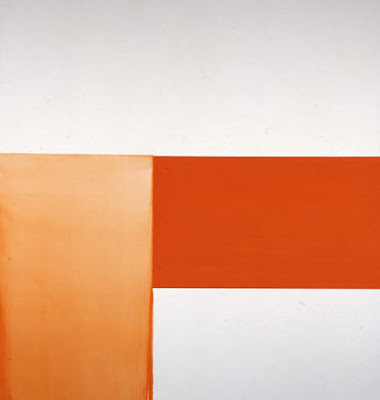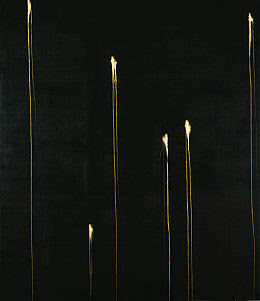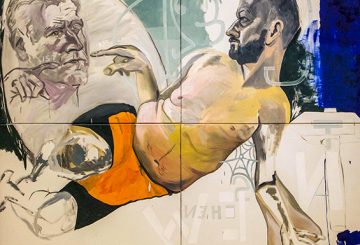From Ian Houston in Sydney…
I’m not ashamed to admit that I love abstract painting. I love the grid, monochromes, gestural works (within reason), hard edge, The New York school I adore De Stijl, and would consider crime to own a Theo van Doesburg. I often think about Rothko‘s suicide and Pollock‘s car crash. I hug Modernists and ask them to hurry back. I encourage Abstract Expressionists and say they should stick with it, their time will come again. I once wanted be a Supremacist but didn’t make the grade. And I have on occasion painted my own lame “abstract works”. So it will surprise no one to know that I loved the Callum Innes show at the MCA. Here’s a man who can use a roll of masking tape. A man who worries about the golden mean, who is seriously concerned about whether an edge should be hard or blurry, who contemplates for great periods of time the necessity of adding another colour to the composition. Who can only paint when the canvas is larger than he is. Does it mean anything? Who the fuck knows. But it’s a lot closer to the Platonic ideality than Tracey Emin.

Callum Innes, Cadmium orange on white.
Callum Innes like many of his ilk, is in awe of the canvas. His work is flat, lean, contemplative and deals unapologetically with the problems of composition, colour and surface. Many of his works pivot on the tension between the hard edge and the painterly blur, solid forms that rest against areas of dissolute paint, sprayed pigments that stain the surface in soft showers of splattered drops and ragged clouds of colour. The metaphoric resonance of such contrast brings to mind human/nature oppositions in which the accident of the gesture works against, under or through the absolutes of the hard edged forms. If one Googles him you’ll find the idea most often referred to in his practice is the notion of “stripping back”, creating compositions from exposing what has been, as well what is. Such techniques lend themselves readily to psychological understandings of subtexts and the unconscious, though I prefer to think of it in terms of plays on narrative, teleology and intention, where the painter seeks to show the past within the present, the metaphysical inevitability of the project rendered in colours that could go nicely with your couch.

Callum Innes, Exposed painting vine black
Indeed to make this task easier, Innes has elected to name many of his paintings after the predominant colour used, as in Exposed Painting Dioxazine Violet. This is significant, as the names that abstract artists use often gives us a clue to where exactly their head is at. After all you may have two painters painting hard edge geometrics, but one may be a deeply religious aesthete such as Barnett Newman whilst the other maybe an atheistic conceptualist such as Daniel Buren. That’s where nomenclature helps, Newman will give his paintings names such as 12 Stations of the Cross whilst Buren goes for something more straightforward – Painting with variable forms. Interestingly Innes seems to want to play both sides of the road with titles that allude, to a poetic disposition but ultimately remain descriptions of the nature of his practise, such as Monologue seven or Exposed Painting, Veronese Green. I find this interesting. It seems to be at the very heart of his practice, this idea of the poetic being an accident, a failing of discipline. The dribble of paint that escapes, its beauty thrown into relief by the hard edges that surround it.

Callum Innes, Six Identified Forms
Works in the show seem to fall into three modes of expression. Hard edged forms, “exposed” turpentine rubbed canvas and splattered, drip action works. Generally each painting will exhibit some interaction between any two of these modalities with the occasional piece being devoted entirely to the one technique. The discipline of his practise is evident in the highly finished nature of the paintings. Every painting is beautifully glazed, every paint surface ideal, every composition entirely realised. They are deeply satisfying aesthetic objects whose surface leads one to the kind of sublime contemplation that was de riguer in 1991. The softness of the pigment, the clouds of colour, the sense of melting away from the hard edge, the depth of blacks and browns leads one inevitably to thoughts of Rothko. The discipline of the line and its betrayal seem to be a theme. Exposed painting cadmium orange is one of a series in which the taped perfection of the square is transgressed by a leak of thinned paint that continues on its own to map out the trajectory of the composition, the looseness of the dribbling paint contrasted with the tightness of the square. The monologue series are, unsurprisingly monochromes, in which the canvas has been stained, wiped, stained and then dribbled with turps, the wash of the solvent leaving track marks across the canvas in varying degrees of tone. The effect is of a vast landscape in which all detail has been rendered into variations of pigment. This staining, washing and toning of the canvas forms the ground for a number of works in which splatters of enamel paint form sparse figures against this tonal wash. The viscosity of the enamel highlighted by the subtlety of the background.
Innes’ work is a kind of philosophical aestheticism in which the effects are achieved through a rigour of composition that seems to appeal to a mystical mathematics. If they are beautiful it is because of their ability to trap the gaze in the rhythms of their logic, the counterpoint between intention and accident, the willed and the circumstantial, trajectory and finish. Like the shows title “From Memory” each work seems to be reaching into time for a perfect moment. An ideal instance of an impossible circumstance. At 46 years of age we can think of Mr Innes as a mid career artist, it will be fascinating to see where his practise leads. More straight lines? Or blurry?
The MCA is so hot right now with Innes and Tim Hawkinson side by side on the top floor, two engaging and successful contemporary artists whose practise couldn’t be more different yet each in their own way showing us that the radically catholic nature of contemporary art seems able to embrace just about anything in its all consuming maw. And that goes without mentioning the radical beauty of Shazia Sikander show at the entry level. I recommend a visit.

